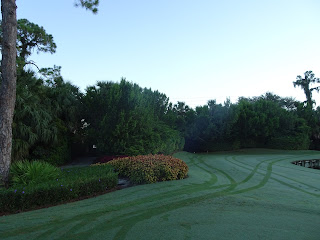Golf Course Report
November 2016
Due to the buzz of activity during the month of October,
this is my first report since the torrential rains of September. How ironic, as I write this update it has
been close to 4 weeks since our last rain event. While preparing to write this report, I took
the time to review the November Report from 2015. At this time last year we were experiencing 90
degree temperatures with high humidity.
That weather was a prelude to a strong El Nino weather pattern that
produced record amounts of rain throughout the winter months. This year is a little closer to “Normal”. As with any weather pattern, we will adjust
and protect as dictated.
The “buzz” I referred to in the previous paragraph
represents the arrival of a whole new fleet of equipment, installation of our
new recycled-water wash area, a fresh coat of pine straw, planting of our winter
Annuals, Palm tree trimming, pressure washing all sidewalks and all the other
little things that may go unnoticed.
The new technology represented in our equipment has already
paid dividends. The setup of the mowers are
more consistent, providing less stress to our turf and producing a healthier
more vigorous growing medium. We are
very optimistic for this Season, our sod project on #17 green has taken well
and we continue to enhance our other weak areas. As we work toward “Tournament Season” we will pay
special attention to the details and other factors effecting playability.
We evolve every year; our goal is to present an enhanced and
different experience each and every Season.
The improved landscaping, the new mowing patterns, the state of the art fairway
program and the multitude of little things will provide an enjoyable experience
for all of our members and guests.
Healthy turf and proper growing conditions give us the
flexibility to adapt to the wants and needs of our clientele; the ability to
make the greens firm and fast, the ability to make them fair and receptive and
everything in between. We are looking
forward to a “Banner Year” at Stonebridge.
It is my goal to be perfect.
We are better this year than last year.
We will be better next year, and we will continue to improve until
perfection is achived.





































